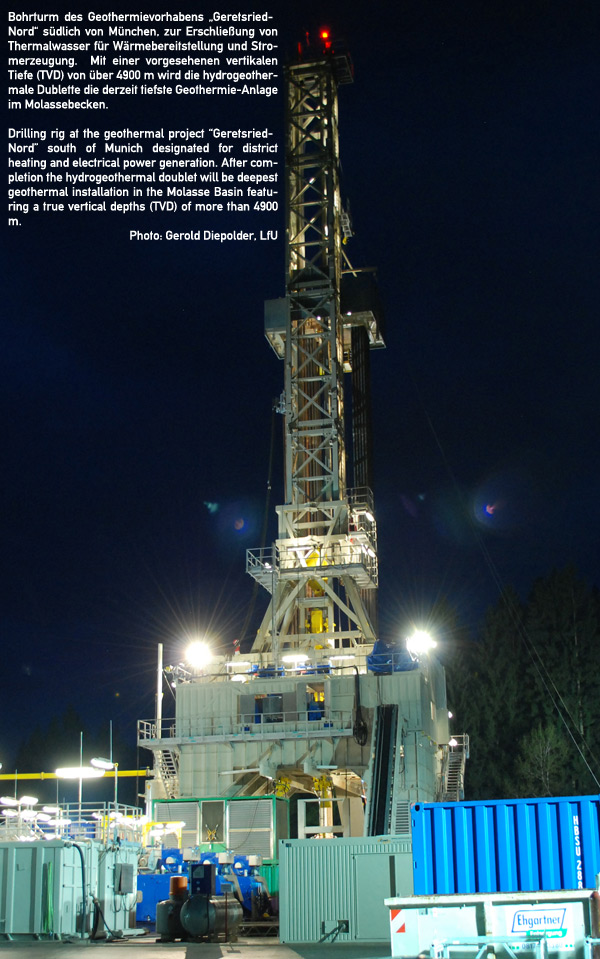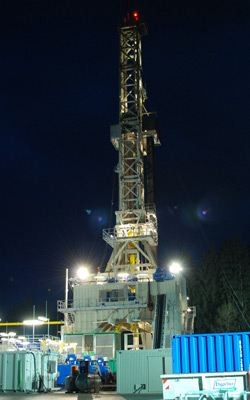Geothermal energy
Drilling rig at the geothermal project Geretsried-Nord
south of Munich designated for district heating and
electrical power generation. After completion the
hydrogeothermal doublet will be deepest geothermal
installation in the Molasse Basin featuring a true
vertical depths (TVD) of more than 4900 m.

south of Munich designated for district heating and
electrical power generation. After completion the
hydrogeothermal doublet will be deepest geothermal
installation in the Molasse Basin featuring a true
vertical depths (TVD) of more than 4900 m.
Geothermal energy refers to the thermal energy generated and stored in the subsurface. The geothermal energy of the Earth's crust originates from the original formation of the planet (about 30%) and from the radioactive decay of minerals in the Earth's interior (about 70%). For the Earth's core, representing more than 15% of the Earth's volume, temperatures between 4800 and 7700°c are assumed, and about 98% of the Earth's interior is hotter than 1000°C. The difference in temperature between the Earth's core and its surface, the so-called geothermal gradient, drives a continuous conduction in the form of heat from the core to the surface and an advective heat transfer by fluids or melts. Generally, temperatures increase at an average of 30 to 40 °C per km, in places of anomalies, such as volcanic areas, subsurface temperatures at this depth can reach several hundred degrees at depths of two or three kilometres forming high enthalpy geothermal resources. In the areas covered by GeoMol, the Molasse basin and the Po basin, no high enthalpy systems exist. Thermal water, thus, occurs only at great depths, but might reach shallower levels when tapped by deep reaching faults.
Shallow geothermal energy, down to depths of less than 400 m, is commonly utilized by heat pumps for space heating and air conditioning. Its efficiency depends mainly on highly localized geological conditions, which are beyond the scope of the project GeoMol. Deep geothermal energy for district heating and electrical energy generation extracted at depths of more than 400 m, however, is a principal issue of this project.
Deep geothermal energy is commonly exploited by tapping hydrothermal resources of deep-seated hot groundwater occurrences. Geothermal water is piped, to surface via deep wells, its heat is extracted by a heat exchanger, and the cooled water is re-injected into the geothermal aquifer. Heat extracted from this closed loop can be used for district heating or, if the water's temperature is well above 100 °C, for the economically viable of electrical power.
The basic requirement for the implementation of hydrothermal energy generation is the presence and sufficient availability of groundwater. In cases of high subsurface temperatures but insufficient water a Hot-Dry-Rock system (also known as Enhanced / Engineered Geothermal System) can be used, whereby water is first injected under pressure into an impermeable heat reservoir to "stimulate" the rock mass by the formation of a network of cracks and fractures. This engineered subsurface heat exchanger thus allows the circulation of water and the extraction of the heat stored in the country rock. Using one or several wells the heated water is produced to surface for energy generation similar to hydrothermal systems.
To run a geothermal power plant efficiently and to avoid mutual interferences with other subsurface uses, a thorough knowledge of the temperature distribution at depth, of the fault and reservoir architecture and the permeability of the reservoir and barrier rocks at a regional scale is essential. The geological and geophysical data collected and interpreted within the scope of GeoMol will underpin regional assessments of geothermal potential. They in turn will serve as a basic planning tool for the sustainable utilization of geothermal resources. Results of GeoMol, however, will not permit the scoping and economic valuation of individual projects. Project-specific feasibility studies will remain indispensable.







 GeoMol is funded by the
GeoMol is funded by the